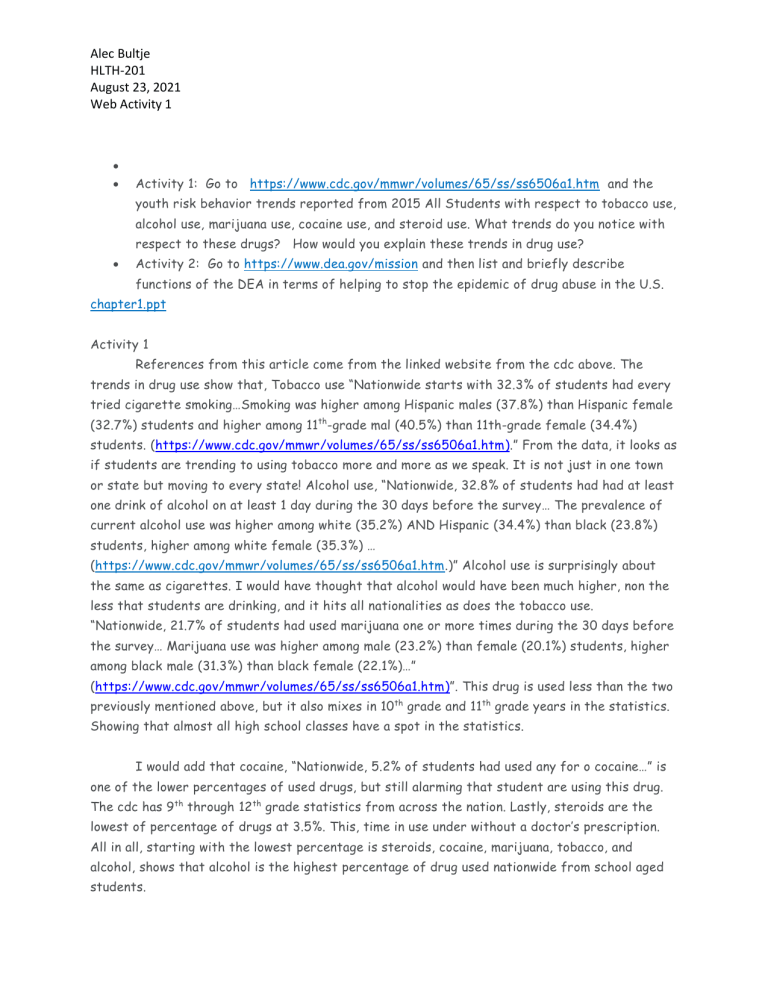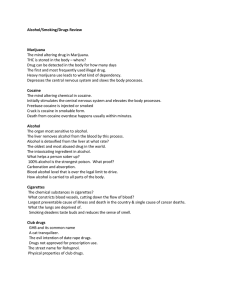
Alec Bultje HLTH-201 August 23, 2021 Web Activity 1 Activity 1: Go to https://www.cdc.gov/mmwr/volumes/65/ss/ss6506a1.htm and the youth risk behavior trends reported from 2015 All Students with respect to tobacco use, alcohol use, marijuana use, cocaine use, and steroid use. What trends do you notice with respect to these drugs? How would you explain these trends in drug use? Activity 2: Go to https://www.dea.gov/mission and then list and briefly describe functions of the DEA in terms of helping to stop the epidemic of drug abuse in the U.S. chapter1.ppt Activity 1 References from this article come from the linked website from the cdc above. The trends in drug use show that, Tobacco use “Nationwide starts with 32.3% of students had every tried cigarette smoking…Smoking was higher among Hispanic males (37.8%) than Hispanic female (32.7%) students and higher among 11th-grade mal (40.5%) than 11th-grade female (34.4%) students. (https://www.cdc.gov/mmwr/volumes/65/ss/ss6506a1.htm).” From the data, it looks as if students are trending to using tobacco more and more as we speak. It is not just in one town or state but moving to every state! Alcohol use, “Nationwide, 32.8% of students had had at least one drink of alcohol on at least 1 day during the 30 days before the survey… The prevalence of current alcohol use was higher among white (35.2%) AND Hispanic (34.4%) than black (23.8%) students, higher among white female (35.3%) … (https://www.cdc.gov/mmwr/volumes/65/ss/ss6506a1.htm.)” Alcohol use is surprisingly about the same as cigarettes. I would have thought that alcohol would have been much higher, non the less that students are drinking, and it hits all nationalities as does the tobacco use. “Nationwide, 21.7% of students had used marijuana one or more times during the 30 days before the survey… Marijuana use was higher among male (23.2%) than female (20.1%) students, higher among black male (31.3%) than black female (22.1%)…” (https://www.cdc.gov/mmwr/volumes/65/ss/ss6506a1.htm)”. This drug is used less than the two previously mentioned above, but it also mixes in 10th grade and 11th grade years in the statistics. Showing that almost all high school classes have a spot in the statistics. I would add that cocaine, “Nationwide, 5.2% of students had used any for o cocaine…” is one of the lower percentages of used drugs, but still alarming that student are using this drug. The cdc has 9th through 12 th grade statistics from across the nation. Lastly, steroids are the lowest of percentage of drugs at 3.5%. This, time in use under without a doctor’s prescription. All in all, starting with the lowest percentage is steroids, cocaine, marijuana, tobacco, and alcohol, shows that alcohol is the highest percentage of drug used nationwide from school aged students. Alec Bultje HLTH-201 August 23, 2021 Web Activity 1 I would explain these trends in drug use as experimental. This could be the case of it being around the student’s home or a friend’s home. Once the experimental phase is gone through, that might be enough for a student to get hooked, then it is passes to the friends and so forth. Doing these drugs in school will have an impact on a student’s health going forward. DEA Investigation and preparation…controlled substance laws operating at interstate and international levels. They are using their training and expertise to limit this use on major hi-ways and roads in the US and worldwide. Investigation and preparation for prosecution of criminals and drug gangs who perpetrate violence in our communities and terrorize citizens through fear and intimidation. They use their training and expertise in helping community members stay safe and keep the gang members at ease. Management of a national drug intelligence program in cooperation with federal, state, local, and foreign officials to collect, analyze, and disseminate strategic and operation drug intelligence information. They use their connections, training and resources to minimize drug warfare. Seizure and forfeiture of assess derived from, traceable to, or intended to be used for illicit drug trafficking. They use their training and resources to stop drug trafficking in its many forms. Enforcement of the provision of the controlled substances act as they pertain to the manufacture, distribution and dispensing of legally produced controlled substances. They oversee and obtain from the laws voted upon from the people to keep legal drugs in order. Coordination and cooperating with federal, state and local law enforcement official on mutual drug enfacement efforts and enhancement of such efforts through exploitation of potential interstate and international investigation beyond local or limed federal jurisdictions and resources. They use their training and resources for the education and mutual drug enforcement for interstate and international levels. Coordination and cooperation with federal, state, and local agencies, and with foreign governments, in programs designed to reduce the availability of illicit abuse-type drugs on the United States market through nonenforcement methods such as crop eradication, crop substitution, and training of foreign officials. They use their resources with federal and state, local agencies to limit abuse drugs that can be grown in a farm like setting. Alec Bultje HLTH-201 August 23, 2021 Web Activity 1 Responsibility, under the policy guidance of the sectary of state and us ambassadors, for all programs associated with drug law enforcement counterparts on foreign countries. They use their connections to keep guidelines in place around the world. Liaison with the United Nations, Interpol, and other organizations on matters relating to international drug control programs. Work with United Nations, and others to control programs that relate to drugs.

